Geological records show that there have been a number of large variations in the Earth’s climate. These have been caused by many natural factors, including changes in the sun, emissions from volcanoes, variations in Earth’s orbit and levels of carbon dioxide (CO2).
Global climate change has typically occurred very slowly, over thousands or millions of years. However, research shows that the current climate is changing more rapidly than shown in geological records.
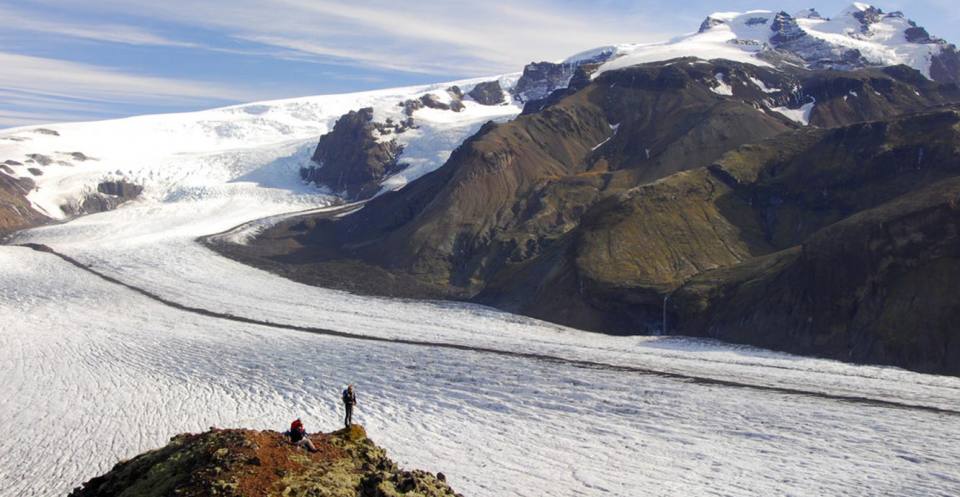
During the last ice age, the UK had many glaciers like this one, which is located in present-day Iceland. BGS © UKRI.
Causes of climate change
Almost all of the energy that affects the climate on Earth originates from the Sun. The Sun’s energy passes through space until it hits the Earth’s atmosphere. Only some of the solar energy intercepted at the top of the atmosphere passes through to the Earth’s surface; some of it is reflected back into space and some is absorbed by the atmosphere.
The energy output of the Sun is not constant: it varies over time and this has an impact on our climate.
The three changes in the Earth’s orbit around the Sun — eccentricity, axial tilt, and precession — are collectively called ‘Milankovitch cycles’.
According to Milankovitch’s theory, these three cycles combine to affect the amount of solar heat that reaches the Earth’s surface and subsequently influences climatic patterns, including periods of glaciation (ice ages). The time period between these changes can be tens of thousands of years (precession and axial tilt) or more than hundreds of thousands of years (eccentricity).
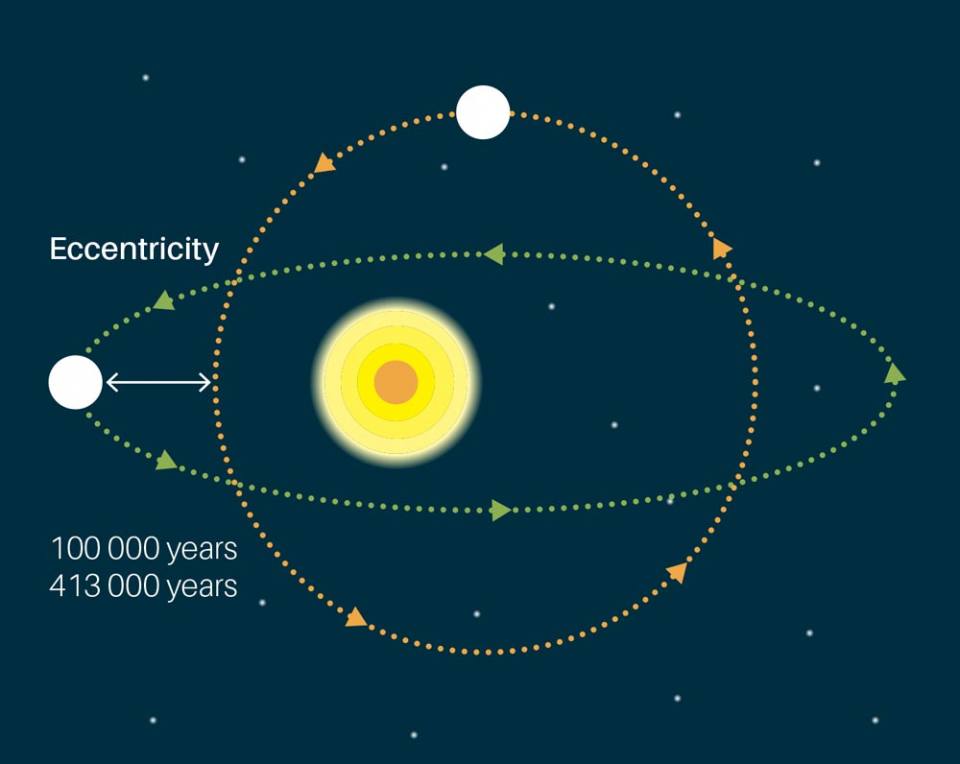
The Earth’s orbit
The Earth’s orbit around the Sun is an ellipse (an oval shape), but it isn’t always the same shape of ellipse. Sometimes, it is almost circular and the Earth stays approximately the same distance from the Sun throughout its orbit. At other times, the ellipse is more pronounced, so that the Earth moves closer and further away from the Sun in its orbit.
When the Earth is closer to the Sun, our climate is warmer and this cycle also affects the length of the seasons. The measure of a shape’s deviation from being a circle, in this case the Earth’s orbit, is called ‘eccentricity’.
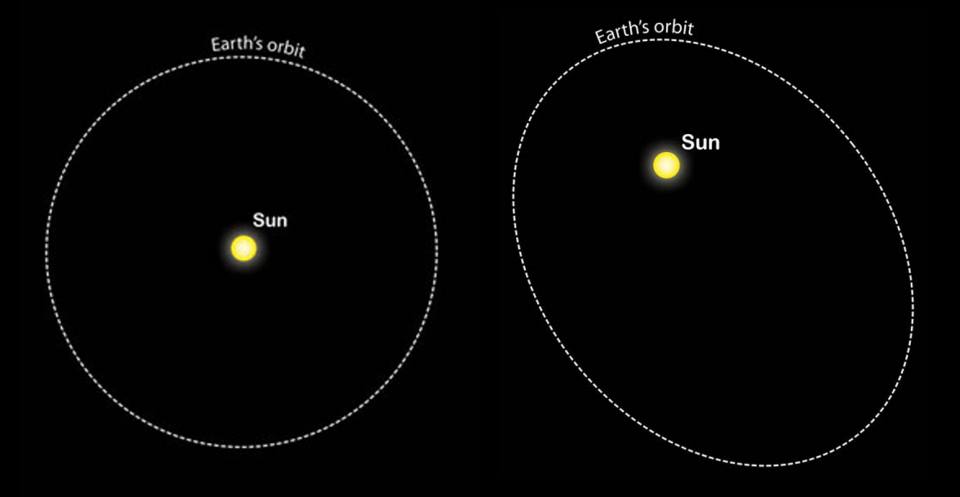
The Earth’s axial tilt
The tilt in the axis of the Earth is called its ‘obliquity’. This angle changes with time, and over about 41 000 years it moves from 22.1° to 24.5° and back again. When the angle increases the summers become warmer and the winters become colder.
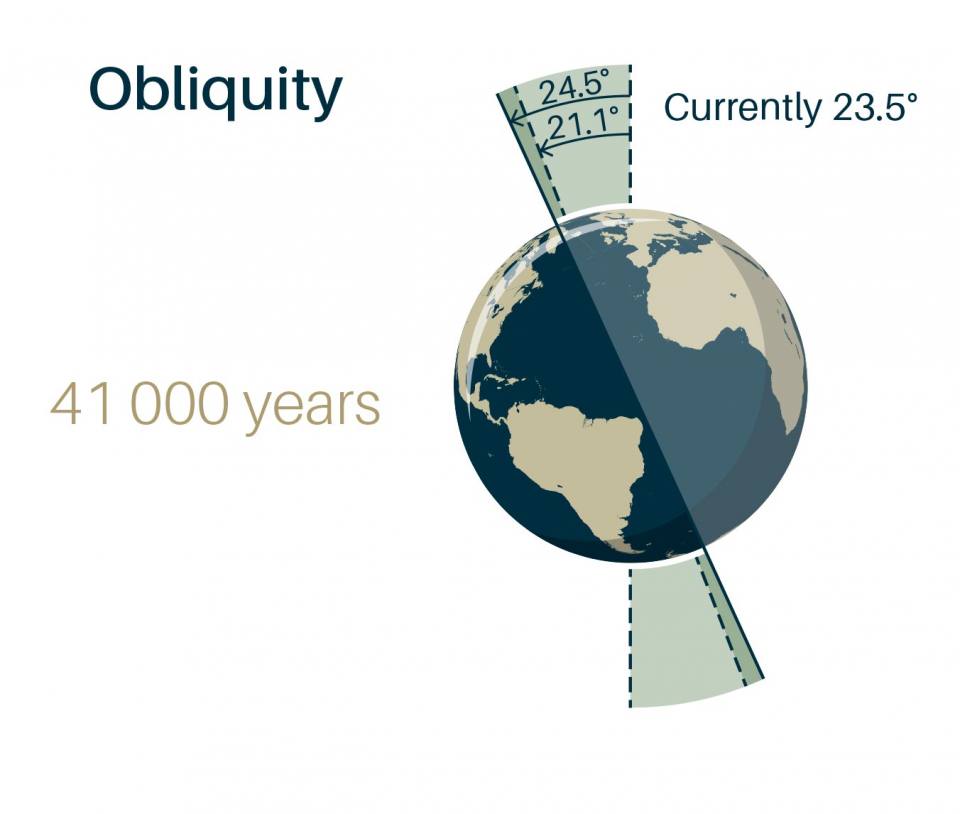
The Earth’s precession
The Earth wobbles on its axis, much like a spinning top that is slowing down. This is called ‘precession’ and is caused by the gravitational pull of the Moon and the Sun upon the Earth. This means that the North Pole changes where it points to in the sky. Currently the Earth’s axis points at Polaris, the North Star, but over thousands of years the axis moves around in a circle and points at different parts of the sky. It impacts on the seasonal contrasts between hemispheres and the timing of the seasons.
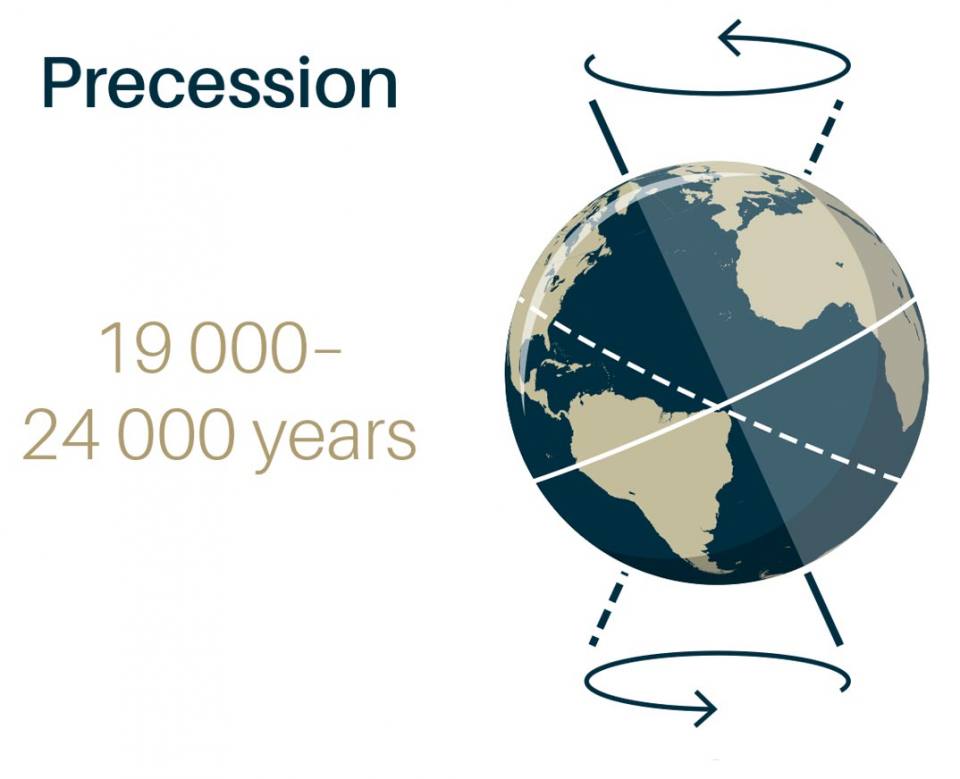
Greenhouse gases include carbon dioxide (CO2), methane (CH4) and water vapour. Water vapour is the most abundant greenhouse gas in the atmosphere, but it stays in the atmosphere for a much shorter period of time: just a few days. CH4 stays in the atmosphere for about nine years until it is removed by oxidation into CO2 and water. CO2 stays in the atmosphere much longer, from years to centuries, contributing to longer periods of warming. These gases trap solar radiation in the Earth’s atmosphere, making the climate warmer.
Changes in ocean currents
Ocean currents carry heat around the Earth. As the oceans absorb more heat from the atmosphere, sea surface temperature increases and the ocean circulation patterns that transport warm and cold water around the globe change. The direction of these currents can shift so that different areas become warmer or cooler. As oceans store a large amount of heat, even small changes in ocean currents can have a large effect on global climate. In particular, increases in sea surface temperature can increase the amount of atmospheric water vapour over the oceans, increasing the quantity of greenhouse gas. If the oceans are warmer they can’t absorb as much carbon dioxide from the atmosphere.
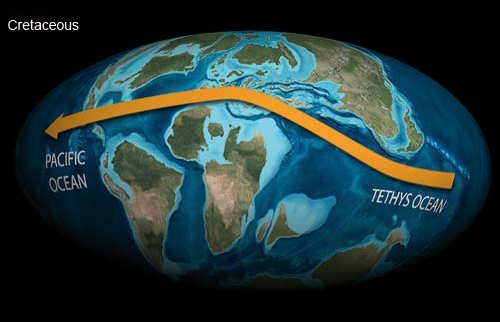
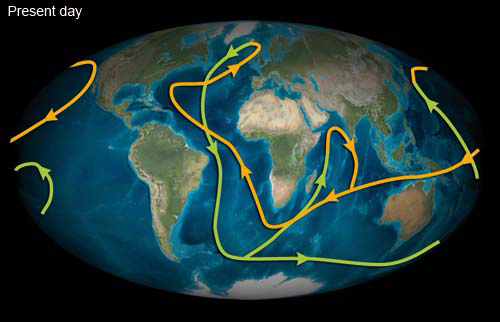
CO2 content of the oceans
The oceans contain more CO2 in total than the atmosphere and exchanges of CO2 occur between the oceans and the atmosphere. CO2 absorbed in ocean water does not trap heat as it does in the atmosphere.
The world’s oceans absorb about a quarter of the CO2 we release into the atmosphere every year. As atmospheric CO2 levels increase so do the ocean’s CO2 levels.
Over very long periods of time, plate tectonic processes cause continents to move to different positions on the Earth. For example, Britain was near to the equator during the Carboniferous Period, around 300 million years ago, and the climate was warmer than it is today. The movement of the plates also causes volcanoes and mountains to form and these can also contribute to a change in climate. Large mountain chains can influence the circulation of air around the globe, and consequently influence the climate. For example, warm air may be deflected to cooler regions by mountains.
Volcanoes affect the climate through the gases and particles (tephra/ash) thrown into the atmosphere during eruptions. The effect of volcanic gases and dust may warm or cool the Earth’s surface, depending on how sunlight interacts with the volcanic material. During major explosive volcanic eruptions, large amounts of volcanic gas, aerosol droplets and ash are released.
Ash falls rapidly, over periods of days and weeks, and has little long-term impact on climate change. However, volcanic gases that are ejected into the stratosphere stay there for much longer periods. Volcanic gases such as sulphur dioxide (SO2) can cause global cooling, but CO2 has the potential to cause global warming.
In the present day, the contribution of volcanic emissions of CO2 into the atmosphere is very small; equivalent to about one per cent of anthropogenic (caused by humans) emissions.
On a global scale, patterns of vegetation and climate are closely correlated. Vegetation absorbs CO2 and this can buffer some of the effects of global warming. On the other hand, desertification amplifies global warming through the release of CO2 because of the decrease in vegetation cover.
A decrease in vegetation cover, via deforestation for example, tends to increase local albedo, leading to surface cooling. Albedo refers to how much light a surface reflects rather than absorbs. Generally, dark surfaces have a low albedo and light surfaces have a high albedo. Ice with snow has a high albedo and reflects around 90 per cent of incoming solar radiation. Land covered with dark-coloured vegetation is likely to have a low albedo and will absorb most of the radiation.
Nowadays, most of what is on the Earth stays on the Earth; very little material is added by meteorites and cosmic dust. However, meteorite impacts have contributed to climate change in the geological past; a good example is the Chicxulub crater, Yucatán Peninsula in Mexico.
Large impacts like Chicxulub can cause a range of effects that include dust and aerosols being ejected high into the atmosphere that prevent sunlight from reaching the Earth. These materials insulate the Earth from solar radiation and cause global temperatures to fall; the effects can last for a few years. After the dust and aerosols fall back to Earth, the greenhouse gases (CO2, water and CH4) caused by the interaction of the impactor and its ‘target rocks’ remain in the atmosphere and can cause global temperatures to increase; these effects can last decades.
Feedbacks
Each of these factors contributes to changes in the Earth’s climate, but the way they interact with each other makes it more complicated. A change in any one of these can lead to additional and enhanced or reduced changes in the others.
For example, we understand that the oceans can take CO2 out of the atmosphere: when the quantity of CO2 in the atmosphere increases, the temperature of the Earth rises. This in turn would contribute to a warming of the oceans. Warm oceans are less able to absorb CO2 than cold ones, so as the temperature rises, the oceans release more CO2 into the atmosphere, which in turn causes the temperature to rise again.
This process is called ‘feedback’. A positive feedback accelerates a temperature rise, whereas a negative feedback slows it down.
You may also be interested in

Discovering Geology
Discovering Geology introduces a range of geoscience topics to school-age students and learners of all ages.
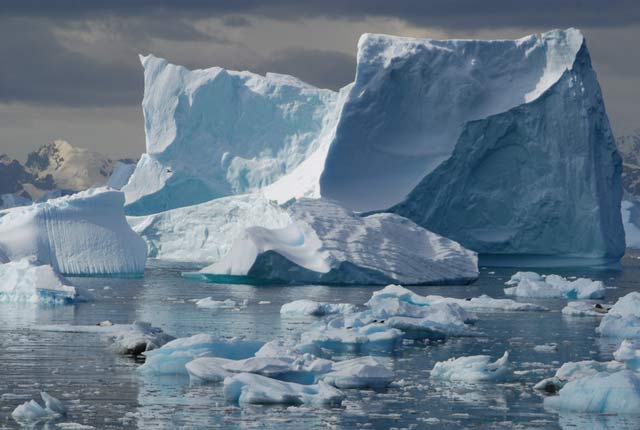
Discovering Geology: climate change
What is the difference between weather and climate? what causes the Earth’s climate to change and what are the impacts? Find out more with our Discovery Geology climate change resources.
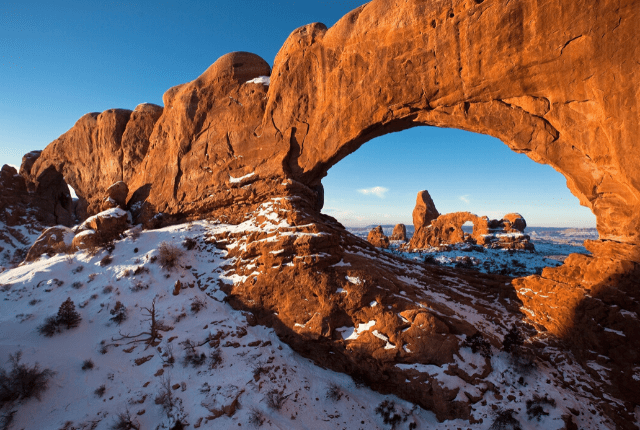
Impacts of climate change
Temperature rises can affect agriculture, sea levels and the frequency of extreme weather incidents. We can study past climate change by looking at the evidence in rocks, fossils and changes in the landscape.
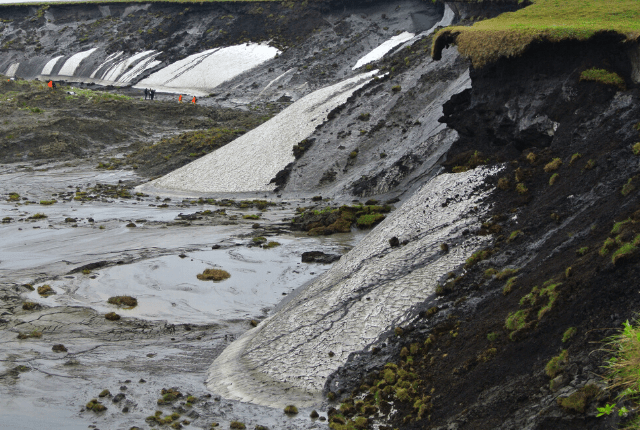
The carbon story
The carbon cycle describes the process in which carbon atoms continually travel from the atmosphere into the Earth, then released back into the atmosphere.
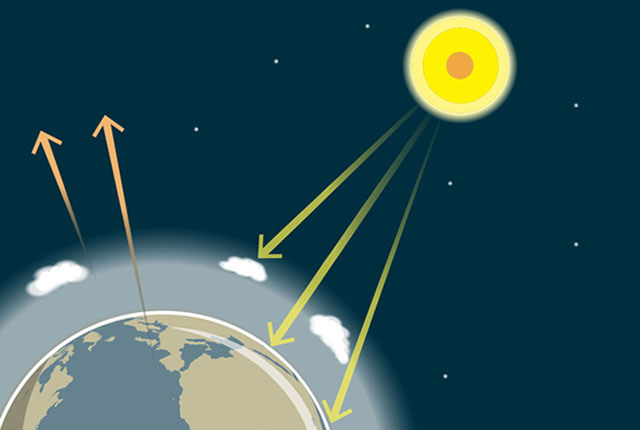
The greenhouse effect
Gases in the Earth’s atmosphere act as an insulating blanket around the planet, trapping more of the Sun’s heat.

Understanding carbon capture and storage
Carbon capture and storage involves capturing carbon dioxide at emission sources, such as power stations, then transporting and storing it underground.
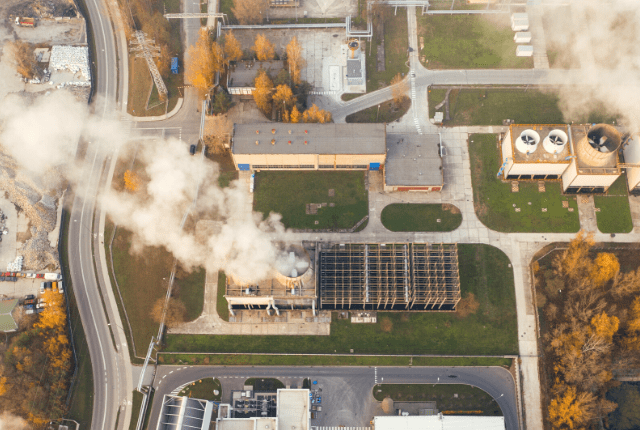
What are we doing about climate change?
BGS is committed to research aimed at slowing down the effects of a changing climate, whilst helping society to become resilient to climate change.



